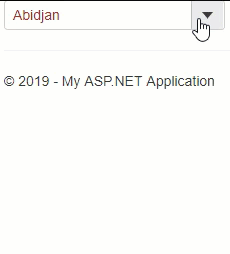Using Razor Syntax
Learn how to add an ASP.NET MVC control in your application using Razor syntax. Also, observe how to add a model, view and controller in an MVC application. When you use MVC Controls in your web application, it reduces the code complexity, increases flexibility, and helps in reusing the code.
type=note
Note: Make sure that the required references are included in the project. For more information about references, see Installation.
Follow the steps below to get started:

Add a Model
Models are required to fetch data for the controls. A model is to be added only where it is required. This example uses Cities.cs model, and steps have been given to explain how to add model in your MVC application.
In the Solution Explorer, right click the folder Models and select Add | New Item. The Add New Item dialog appears.
In the Add New Item dialog, expand the Installed tab towards left and select Code | Class.
Set the name of the class (for example:
Cities.cs), and then click Add.Add the following code to Cities.cs model. We are using Cities class to represent a list of countries.
public class Cities { public static List<string> GetCities() { return new List<string> { "Abidjan", "Accra", "Ahmedabad", "Alexandria", "Ankara", "Atlanta", "Baghdad", "Bandung", "Bangkok", "Barcelona", "Beijing", "Belo Horizonte", "Bengaluru", "Bogota", "Boston", "Buenos Aires", "Cairo", "Calcutta", "Chengdu", "Chennai", "Chicago", "Chongqung", "Dalian", "Dallas", "Delhi", "Detroit", "Dhaka", "Dongguan", "Essen", "Fuzhou", "Guadalajara", "Guangzhou", "Hangzhou", "Harbin", "Ho Chi Minh City", "Hong Kong", "Houston", "Hyderabad", "Istanbul", "Jakarta", "Johannesburg", "Karachi", "Khartoum", "Kinshasa", "Kuala Lumpur", "Lagos", "Lahore", "Lima", "London", "Los Angeles", "Luanda", "Madrid", "Manila", "Medellin", "Mexico City", "Miami", "Milan", "Monterrey", "Moscow", "Mumbai", "Nagoya", "Nanjing", "Naples", "New York", "Osaka", "Paris", "Pheonix", "Philadelphia", "Porto Alegre", "Pune", "Qingdao", "Quanzhou", "Recife", "Rio de Janeiro", "Riyadh", "Rome", "Saint Petersburg", "Salvador", "San Francisco", "Santiago", "Sao Paulo", "Seoul", "Shanghair", "Shenyang", "Shenzhen", "Singapore", "Surabaya", "Surat", "Suzhou", "Sydney", "Taipei", "Tehran", "Tianjin", "Toronto", "Washington", "Wuhan", "Xi'an-Xianyang", "Yangoon", "Zhengzhou", "Tokyo" }; } }A new class is added to the application.
Add a Controller
Controllers are simple class files. They are responsible for handling incoming requests to the application, retrieve data, and then specify view templates that return a response to the client.
In the Solution Explorer, right click the folder Controllers.
From the context menu, select Add | New Item. The Add New Item dialog appears.
Complete the following steps in the Add New Item dialog:
- In the Installed tab, select ASP.NET Core | Controller Class.
- Set name of the controller (For example:
ComboBoxController). - Click Add.
Add the following code to replace the Index() method.
using <ApplicationName>.Models public ActionResult Index() { ViewBag.Cities = Cities.GetCities(); return View(); }A new controller is added to the application within the folder Controllers.
Add the Control
View helps the user to view a visual representation of the model. View is most commonly associated with model and retrieves the data required with the help of controllers. We will add a code in the Index.cshtml to view ComboBox control in the browser.
- From the Solution Explorer, right click the folder Views and select Add | New Folder.
- Name the new folder. Provide the same name as the name of your controller, minus the suffix Controller (in our example: ComboBox).
- Right click the folder ComboBox, and select Add | New Item. The Add New Item dialog appears.
- Complete the following steps in the Add New Item dialog:
- In the Installed tab towards left, and select ASP.NET Core | Razor View.
- Set name of the view (for example: Index.cshtml).
- Click Add.
For View
In the Index.cshtml file, replace the default code with the code given below to initialize ComboBox control.
@{List<string> cities = ViewBag.Cities;}
<div>
<c1-combo-box selected-index = "0">
<c1-items-source source-collection = "@cities"></c1-items-source>
</c1-combo-box>
</div>
Apply custom CSS
The appearance of the controls is defined using CSS classes. These classes can be customized further using custom CSS rules to change the appearance of controls. The following example illustrates how you can apply custom CSS to the ComboBox control to customize its appearance. For more information on using custom css, see Styling and CSS.
<style>
.wj-combobox {
color: brown;
}
.wj-listbox-item {
font-size: 11pt;
font-weight: bold;
font-family:Calibri;
background-color:burlywood;
}
</style>
Build and Run the Project
- Click Build | Build Solution to build the project.
- Press F5 to run the project.
type=note
Append the folder name and view name to the generated URL (for example: http://localhost:1234/ComboBox/index) in the address bar of the browser to see the view.


